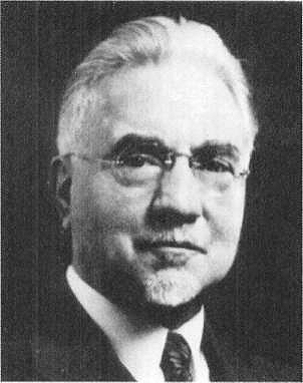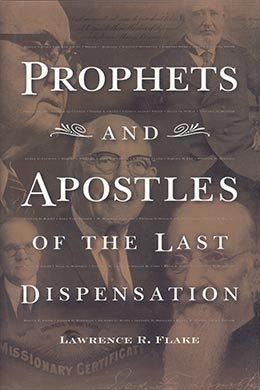John Andreas Widtsoe
Lawrence R. Flake, Prophets and Apostles of the Last Dispensation (Provo, UT: Religious Studies Center, Brigham Young University, 2001), 453–56.

Born: 31 January 1872, Daloe, Isle of Froyen, Trondhjem, Norway
Quorum of the Twelve Apostles: 17 March 1921 (age 49)
Died: 29 November 1952 (age 80), Salt Lake City, Utah
He followed no well-worn road, he had no early advantage. He came to earth in an inconspicuous place, on a rocky island among fisher folk on a winter night, with the wind adding its cold and comfortless sounds to the breaking waves of the North Sea. It was little expected that he should live. He was born with his hand attached to his head, and a crude operation had to be performed.” [1]
The baby described in these words of Richard L. Evans was John Andreas Widtsoe, and the place was the Isle of Froyen, Norway. To add to his early disadvantages, John’s father died when the boy was six, and at about the same time his mother became a near outcast by espousing a strange religious sect known as “Mormonism.” But because of her newly found faith and her indomitable desire to improve the opportunities of her two sons, she set sail for America, the land of abundant resources.
In their stopover at Liverpool, England, from where they embarked, young John displayed early the quality that became one of the driving forces of his life—his thirst for knowledge. Instead of waiting around for the boat to leave, the eleven-year-old lad hurried off to a museum. The boyish Norwegian scrawl in his journal that day read, “There was more to see than I thought could be collected in one place.” [2]
In Logan, Utah, John entered Brigham Young College and graduated in 1891 at the age of nineteen. His mother had no qualms about undertaking what many of her associates thought was a rash and foolish venture for a poor widow—she sent him to Harvard, paying for this expensive privilege by long hours of sewing and by mortgaging all she had. John was one of a group of promising young Latter-day Saint men who were encouraged to attend Harvard by Dr. Joseph M. Tanner of Brigham Young College in Logan. This group of Mormon students enjoyed one another’s company and kept their expenses down by renting a house together in Cambridge, Massachusetts. [3] It was here at Harvard that John found deep and lasting conviction concerning the truthfulness of the gospel. He wrote: “At that time I was having my religious battles. Was Mormonism what it pretended to be? Did Joseph Smith tell the truth? I read, listened, compared, thought, prayed. It was a real search for truth. Out of it in time came the certain knowledge that the restored gospel is true and that Joseph Smith was indeed a Prophet, and the restorer of the simple true gospel of Jesus Christ. There has never been any doubt about it since that time of deep study and prayer.” [4] He graduated in 1894, receiving the highest possible honors, including two awards that had never been presented to the same person before—one for demonstrating the greatest breadth of knowledge and the other for demonstrating the greatest depth of knowledge. Though he had many opportunities to go elsewhere at higher pay, John A. Widtsoe accepted a position at the Utah Agricultural College, where he could serve the people and kingdom he loved. Brother Widtsoe saw the forces of God at work in science. Once when doubts arose in his mind and he felt as if he might be losing his faith, he pled with the Lord for help. He expressed this earnest prayer by writing a beautiful hymn entitled “Father, Lead Me out of Darkness.” The Lord answered his prayer; his faith was strengthened and his testimony grew.
In 1898 Brother Widtsoe entered into a happy marriage with Leah Dunford. Seven children were born to them, but even in this blessing his path was not easy—four of them died in infancy and Marsel, their only son, died in the prime of young manhood. Following his marriage, John traveled to Europe to study chemistry at Goettingen, Germany, and Zurich, Switzerland, returning again to Utah in 1900. For the next twenty years he pursued his career in agricultural science and education with ardor and success. He directed the experimental station at Utah Agricultural College and wrote two revolutionary books that had worldwide impact—one on dry farming and the other on irrigation. In 1907 he became president of the college, an assignment that he never desired, feeling that science, not administration, was where he could make his best contribution. He felt a strong sense of duty, however, to serve where he was called and later, with the same motive, accepted the presidency of the University of Utah.
His call to the Quorum of the Twelve in 1921 afforded Elder Widtsoe increased opportunity to continue his impressive record of service to the Lord. He presided over the European missions and served the Church in the Genealogical Society, on the Church Board of Education, on the General Welfare Committee, as editor of the Improvement Era, and in many other assignments. Upon the advice of the president of the Church, he also responded to many important public calls, such as accompanying an exploring expedition down the Colorado River in search of dam sites, helping to design the famous Colorado River Compact, and examining for the government some serious problems, financial and otherwise, in the Bureau of Reclamation. He often performed these services without pay.
Amidst all of the prominence, achievement, and scientific learning of this great man, one truth was his greatest treasure. At Elder Widtsoe’s death in November 1952, President Joseph Fielding Smith pinpointed this most important knowledge: “He knew without any doubt that Jesus is the Christ, the Redeemer of the world and the Savior of all men . . . and this was Elder Widtsoe’s message as a special witness for Christ to all the world.” [5]
Notes
[1] Richard L. Evans, “John A. Widtsoe—1872–1952,” ed. Marba C. Josephson, Improvement Era, January 1953,58.
[2] Albert E. Bowen, “John A. Widtsoe: Scientist—Public Servant—Friend,” Improvement Era, January 1952, 18.
[3] John A. Widtsoe, In a Sunlit Land: The Autobiography of John A. Widtsoe (Salt Lake City: Deseret News Press, 1952), 26, 28.
[4] Widtsoe, In a Sunlit Land, 37.
[5] Joseph Fielding Smith, “Elder John A. Widtsoe,” Relief Society Magazine, January 1953, 13.
